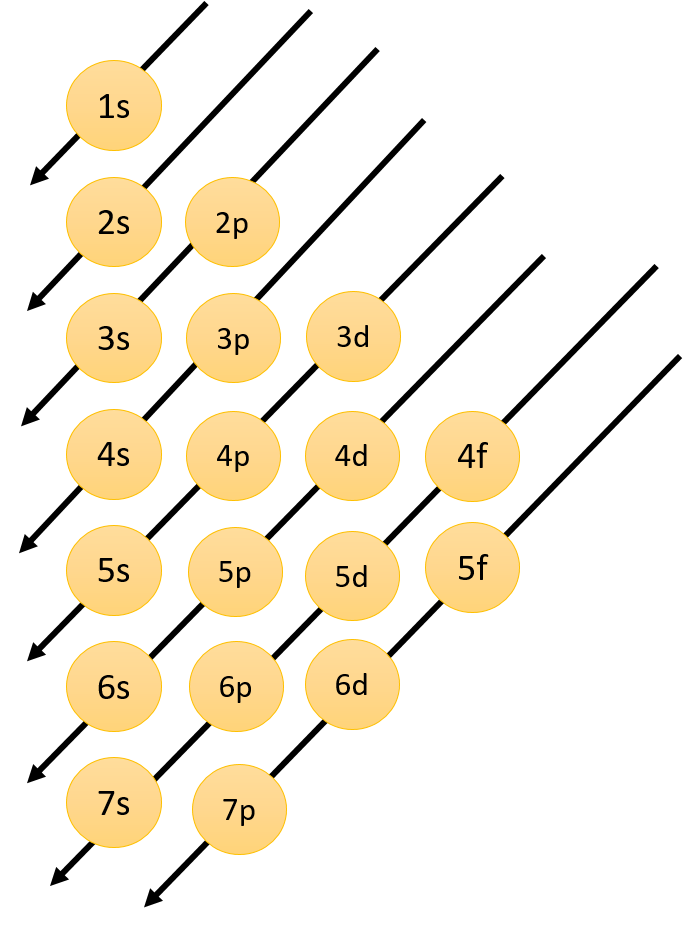
In potassium, the order of energy levels is:
(A) $3s > 3d$
(B) $4s < 3d$
(C) $4s > 4p$
(D) $4s = 3d$
Answer
119.4k+ views
Hint: The electronic configuration of potassium is $[Ar]4{s^1}$. Aufbau principle states that in the ground state of atoms, the orbitals are filled in the order of their increasing energies.
Complete step by step solution:
According to the Aufbau principle, the electrons first occupy the lowest energy orbital available to them and enter into higher energy orbitals only when the lower energy orbitals are filled. The order in which the energies of the orbitals increase and also the order in which the orbitals are filled are $1s,2s,2p,3s,3p,4s,3d,5s,4d,5p,6s,......$
This can be easily understood by the following diagram:

The energy of the orbitals depends upon the principal quantum number ($n$) and azimuthal quantum number ($l$). Orbital energy increases as ($n + l$) increases. So lower the value of ($n + l$) for an orbital, the lower is its energy. If there are two orbitals with the same value of ($n + l$) the one with the smaller value of $n$ has the lower energy.
Therefore a subshell with a lower value of ($n + l$) possess lower energy and is filled first. Let us consider $4s$ and $3d$ subshell.
For $4s$ subshell, $n + l = 4 + 0 = 4$,
while for 3d subshell, $n + l = 3 + 2 = 5$.
Hence, the ($n + l$) value of $4s$ subshell is lower than that of $3d$ subshell, so its energy is lower than that of $3d$ subshell. Thus, the $4s$ subshell is filled before the $3d$ subshell.
In the case of potassium ($K$) (atomic number ($Z$) =$19$), the electronic configuration is $1{s^2}2{s^2}2{p^6}3{s^2}3{p^6}4{s^1}$. From the electronic configuration, it can be observed that the last electron of the potassium entered into the $4s$ subshell instead of the $3d$ subshell. This is because the energy of $4s$ subshell is lower than that of $3d$ subshell as illustrated above.
Hence, option (B) is the correct answer.
Note: The energies of different orbitals drop to a different extent with an increase in atomic number because of the effective nuclear charge. The half-filled and completely filled subshells possess extra stability due to the symmetrical distribution of electrons and greater exchange energy. That is why the electronic configuration of some elements are exceptional and not in accordance with the normal order of filling. E.g., Cr ($Z = 24$) and Cu ($Z = 29$).
Complete step by step solution:
According to the Aufbau principle, the electrons first occupy the lowest energy orbital available to them and enter into higher energy orbitals only when the lower energy orbitals are filled. The order in which the energies of the orbitals increase and also the order in which the orbitals are filled are $1s,2s,2p,3s,3p,4s,3d,5s,4d,5p,6s,......$
This can be easily understood by the following diagram:

The energy of the orbitals depends upon the principal quantum number ($n$) and azimuthal quantum number ($l$). Orbital energy increases as ($n + l$) increases. So lower the value of ($n + l$) for an orbital, the lower is its energy. If there are two orbitals with the same value of ($n + l$) the one with the smaller value of $n$ has the lower energy.
Therefore a subshell with a lower value of ($n + l$) possess lower energy and is filled first. Let us consider $4s$ and $3d$ subshell.
For $4s$ subshell, $n + l = 4 + 0 = 4$,
while for 3d subshell, $n + l = 3 + 2 = 5$.
Hence, the ($n + l$) value of $4s$ subshell is lower than that of $3d$ subshell, so its energy is lower than that of $3d$ subshell. Thus, the $4s$ subshell is filled before the $3d$ subshell.
In the case of potassium ($K$) (atomic number ($Z$) =$19$), the electronic configuration is $1{s^2}2{s^2}2{p^6}3{s^2}3{p^6}4{s^1}$. From the electronic configuration, it can be observed that the last electron of the potassium entered into the $4s$ subshell instead of the $3d$ subshell. This is because the energy of $4s$ subshell is lower than that of $3d$ subshell as illustrated above.
Hence, option (B) is the correct answer.
Note: The energies of different orbitals drop to a different extent with an increase in atomic number because of the effective nuclear charge. The half-filled and completely filled subshells possess extra stability due to the symmetrical distribution of electrons and greater exchange energy. That is why the electronic configuration of some elements are exceptional and not in accordance with the normal order of filling. E.g., Cr ($Z = 24$) and Cu ($Z = 29$).
Recently Updated Pages
The hybridization and shape of NH2 ion are a sp2 and class 11 chemistry JEE_Main

Total number of orbitals associated with the 3rd shell class 11 chemistry JEE_Main

Which of the following has the lowest boiling point class 11 chemistry JEE_Main

Which of the following compounds has zero dipole moment class 11 chemistry JEE_Main

Number of g of oxygen in 322 g Na2SO410H2O is Molwt class 11 chemistry JEE_Main

In the neutralization process of H3PO4 and NaOH the class 11 chemistry JEE_Main

Trending doubts
JEE Main 2025: Application Form (Out), Exam Dates (Released), Eligibility & More

JEE Main Login 2045: Step-by-Step Instructions and Details

JEE Main Chemistry Question Paper with Answer Keys and Solutions

Learn About Angle Of Deviation In Prism: JEE Main Physics 2025

JEE Main 2025: Conversion of Galvanometer Into Ammeter And Voltmeter in Physics

JEE Main Exam Marking Scheme: Detailed Breakdown of Marks and Negative Marking

Other Pages
NCERT Solutions for Class 11 Chemistry Chapter 7 Redox Reaction

NCERT Solutions for Class 11 Chemistry Chapter 5 Thermodynamics

NCERT Solutions for Class 11 Chemistry Chapter 8 Organic Chemistry

NCERT Solutions for Class 11 Chemistry Chapter 6 Equilibrium

NCERT Solutions for Class 11 Chemistry Chapter 9 Hydrocarbons

Equilibrium Class 11 Notes: CBSE Chemistry Chapter 6




